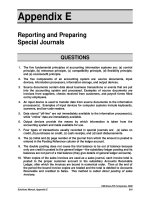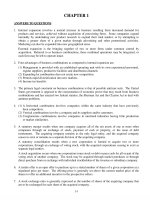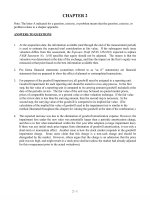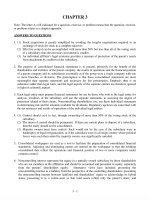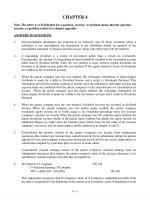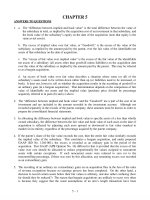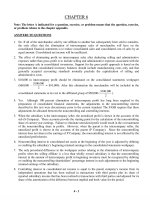Solution manual advanced accounting 4e by jeter
Bạn đang xem bản rút gọn của tài liệu. Xem và tải ngay bản đầy đủ của tài liệu tại đây (5.23 MB, 721 trang )
To download more slides, ebook, solutions and test bank, visit
CHAPTER 1
ANSWERS TO QUESTIONS
1. Internal expansion involves a normal increase in business resulting from increased demand for
products and services, achieved without acquisition of preexisting firms. Some companies expand
internally by undertaking new product research to expand their total market, or by attempting to
obtain a greater share of a given market through advertising and other promotional activities.
Marketing can also be expanded into new geographical areas.
External expansion is the bringing together of two or more firms under common control by
acquisition. Referred to as business combinations, these combined operations may be integrated, or
each firm may be left to operate intact.
2. Four advantages of business combinations as compared to internal expansion are:
(1) Management is provided with an established operating unit with its own experienced personnel,
regular suppliers, productive facilities and distribution channels.
(2) Expanding by combination does not create new competition.
(3) Permits rapid diversification into new markets.
(4) Income tax benefits.
3. The primary legal constraint on business combinations is that of possible antitrust suits. The United
States government is opposed to the concentration of economic power that may result from business
combinations and has enacted two federal statutes, the Sherman Act and the Clayton Act to deal with
antitrust problems.
4. (1) A horizontal combination involves companies within the same industry that have previously
been competitors.
(2) Vertical combinations involve a company and its suppliers and/or customers.
(3) Conglomerate combinations involve companies in unrelated industries having little production
or market similarities.
5. A statutory merger results when one company acquires all of the net assets of one or more other
companies through an exchange of stock, payment of cash or property, or the issue of debt
instruments. The acquiring company remains as the only legal entity, and the acquired company
ceases to exist or remains as a separate division of the acquiring company.
A statutory consolidation results when a new corporation is formed to acquire two or more
corporations, through an exchange of voting stock, with the acquired corporations ceasing to exist as
separate legal entities.
A stock acquisition occurs when one corporation issues stock or debt or pays cash for all or part of the
voting stock of another company. The stock may be acquired through market purchases or through
direct purchase from or exchange with individual stockholders of the investee or subsidiary company.
6. A tender offer is an open offer to purchase up to a stated number of shares of a given corporation at a
stipulated price per share. The offering price is generally set above the current market price of the
shares to offer an additional incentive to the prospective sellers.
7. A stock exchange ratio is generally expressed as the number of shares of the acquiring company that
are to be exchanged for each share of the acquired company.
1-1
To download more slides, ebook, solutions and test bank, visit
8. Defensive tactics include:
(1) Poison pill – when stock rights are issued to existing stockholders that enable them to purchase
additional shares at a price below market value, but exercisable only in the event of a potential
takeover. This tactic is effective in some cases.
(2) Greenmail – when the shares held by a would-be acquiring firm are purchased at an amount
substantially in excess of their fair value. The shares are then usually held in treasury. This tactic is
generally ineffective.
(3) White knight or white squire – when a third firm more acceptable to the target company
management is encouraged to acquire or merge with the target firm.
(4) Pac-man defense – when the target firm attempts an unfriendly takeover of the would-be
acquiring company.
(5) Selling the crown jewels – when the target firms sells valuable assets to others to make the firm
less attractive to an acquirer.
9. In an asset acquisition, the firm must acquire 100% of the assets of the other firm, while in a stock
acquisition, a firm may gain control by purchasing 50% or more of the voting stock. Also, in a stock
acquisition, formal negotiations with the target’s management can sometimes be avoided. Further, in
a stock acquisition, there might be advantages in keeping the firms as separate legal entities such as
for tax purposes.
10. Does the merger increase or decrease expected earnings performance of the acquiring institution?
From a financial and shareholder perspective, the price paid for a firm is hard to justify if earnings per
share declines. When this happens, the acquisition is considered dilutive. Conversely, if the earnings
per share increases as a result of the acquisition, it is referred to as an accretive acquisition.
11. Under the parent company concept, the writeup or writedown of the net assets of the subsidiary in
the consolidated financial statements is restricted to the amount by which the cost of the investment
is more or less than the book value of the net assets acquired. Noncontrolling interest in net assets is
unaffected by such writeups or writedowns.
The economic unit concept supports the writeup or writedown of the net assets of the subsidiary by
an amount equal to the entire difference between the fair value and the book value of the net assets
on the date of acquisition. In this case, noncontrolling interest in consolidated net assets is adjusted
for its share of the writeup or writedown of the net assets of the subsidiary.
12. a) Under the parent company concept, noncontrolling interest is considered a liability of the
consolidated entity whereas under the economic unit concept, noncontrolling interest is
considered a separate equity interest in consolidated net assets.
b) The parent company concept supports partial elimination of intercompany profit whereas the
economic unit concept supports 100 percent elimination of intercompany profit.
c) The parent company concept supports valuation of subsidiary net assets in the consolidated
financial statements at book value plus an amount equal to the parent company’s percentage
interest in the difference between fair value and book value. The economic unit concept
supports valuation of subsidiary net assets in the consolidated financial statements at their fair
value on the date of acquisition without regard to the parent company’s percentage ownership
interest.
d) Under the parent company concept, consolidated net income measures the interest of the
shareholders of the parent company in the operating results of the consolidated entity. Under the
1-2
To download more slides, ebook, solutions and test bank, visit
economic unit concept, consolidated net income measures the operating results of the
consolidated entity which is then allocated between the controlling and noncontrolling interests.
13. The implied fair value based on the price may not be relevant or reliable since the price paid is a
negotiated price which may be impacted by considerations other than or in addition to the fair value
of the net assets of the acquired company. There may be practical difficulties in determining the
fair value of the consideration given and in allocating the total implied fair value to specific assets
and liabilities.
In the case of a less than wholly owned company, valuation of net assets at implied fair value
violates the cost principle of conventional accounting and results in the reporting of subsidiary
assets and liabilities using a different valuation procedure than that used to report the assets and
liabilities of the parent company.
14. The economic entity is more consistent with the principles addressed in the FASB’s conceptual
framework. It is an integral part of the FASB’s conceptual framework and is named specifically in
SFAC No. 5 as one of the basic assumptions in accounting. The economic entity assumption views
economic activity as being related to a particular unit of accountability, and the standard indicates
that a parent and its subsidiaries represent one economic entity even though they may include
several legal entities.
15. The FASB’s conceptual framework provides the guidance for new standards. The quality of
comparability was very much at stake in FASB’s decision in 2001 to eliminate the pooling of
interests method for business combinations. This method was also argued to violate the historical
cost principle as it essentially ignored the value of the consideration (stock) issued for the
acquisition of another company.
The issue of consistency plays a role in the recent proposal to shift from the parent concept to the
economic entity concept, as the former method valued a portion (the noncontrolling interest) of a
given asset at prior book values and another portion (the controlling interest) of that same asset at
exchange-date market value.
16. Comprehensive income is a broader concept, and it includes some gains and losses explicitly stated
by FASB to bypass earnings. The examples of such gains that bypass earnings are some changes in
market values of investments, some foreign currency translation adjustments and certain gains and
losses, related to minimum pension liability.
In the absence of gains or losses designated to bypass earnings, earnings and comprehensive
income are the same.
1-3
To download more slides, ebook, solutions and test bank, visit
ANSWERS TO BUSINESS ETHICS CASE
1. The third item will lead to the reduction of net income of the acquired company before
acquisition, and will increase the reported net income of the combined company subsequent to
acquisition. The accelerated payment of liabilities should not have an effect on net income in
current or future years, nor should the delaying of the collection of revenues (assuming those
revenues have already been recorded).
2. The first two items will decrease cash from operations prior to acquisition and will increase cash
from operations subsequent to acquisition. The third item will not affect cash from operations.
3. As the manager of the acquired company I would want to make it clear that my future
performance (if I stay on with the consolidated company) should not be evaluated based upon a
future decline that is perceived rather than real. Further, I would express a concern that
shareholders and other users might view such accounting maneuvers as sketchy.
4.
a) Earnings manipulation may be regarded as unethical behavior regardless of which side of
the acquirer/acquiree equation you’re on. The benefits that you stand to reap may differ,
and thus your potential liability may vary. But the ethics are essentially the same.
Ultimately the company may be one unified whole as well, and the users that are affected
by any kind of distorted information may view any participant in an unsavory light.
b) See answer to (a).
1-4
To download more slides, ebook, solutions and test bank, visit
ANSWERS TO EXERCISES
Exercise 1-1
Part A Normal earnings for similar firms = ($15,000,000 - $8,800,000) x 15% = $930,000
Expected earnings of target:
Pretax income of Condominiums, Inc., 2008
Subtract: Additional depreciation on building ($960,000
Target’s adjusted earnings, 2008
$1,200,000
(288,000)
30%)
912,000
Pretax income of Condominiums, Inc., 2009
Subtract: Additional depreciation on building
Target’s adjusted earnings, 2009
$1,500,000
(288,000)
1,212,000
Pretax income of Condominiums, Inc., 2010
Add: Extraordinary loss
Subtract: Additional depreciation on building
Target’s adjusted earnings, 2010
Target’s three year total adjusted earnings
Target’s three year average adjusted earnings ($3,086,000
$950,000
300,000
(288,000)
3)
962,000
3,086,000
1,028,667
Excess earnings of target = $1,028,667 - $930,000 = $98,667 per year
Present value of excess earnings (perpetuity) at 25%:
$98 ,667
= $394,668 (Estimated Goodwill)
25 %
Implied offering price = $15,000,000 – $8,800,000 + $394,668 = $6,594,668.
Part B Excess earnings of target (same as in Part A) = $98,667
Present value of excess earnings (ordinary annuity) for three years at 15%:
$98,667 2.28323 = $225,279
Implied offering price = $15,000,000 – $8,800,000 + $225,279 = $6,425,279.
Note: The sales commissions and depreciation on equipment are expected to continue at the
same rate, and thus do not necessitate adjustments.
1-5
To download more slides, ebook, solutions and test bank, visit
Exercise 1-2
Part A Cumulative 5 years net cash earnings
Add nonrecurring losses
Subtract extraordinary gains
Five-years adjusted cash earnings
$831,000
Average annual adjusted cash earnings
5
$850,000
48,000
(67,000)
$831,000
$166,200
(a) Estimated purchase price = present value of ordinary annuity of $166,200 (n=5, rate= 15%)
$166,200 3.35216 =
$557,129
(b) Less: Market value of identifiable assets of Beta
Less: Liabilities of Beta
Market value of net identifiable assets
Implied value of goodwill of Beta
$750,000
320,000
Part B Actual purchase price
Market value of identifiable net assets
Goodwill purchased
430,000
$127,129
$625,000
430,000
$195,000
Exercise 1-3
Part A
Normal earnings for similar firms (based on tangible assets only) = $1,000,000 x 12% = $120,000
Excess earnings = $150,000 – $120,000 = $30,000
(1)
Goodwill based on five years excess earnings undiscounted.
Goodwill = ($30,000)(5 years) = $150,000
(2)
Goodwill based on five years discounted excess earnings
Goodwill = ($30,000)(3.6048) = $108,144
(present value of an annuity factor for n=5, I=12% is 3.6048)
(3)
Goodwill based on a perpetuity
Goodwill = ($30,000)/.20 = $150,000
Part B
The second alternative is the strongest theoretically if five years is a reasonable representation of
the excess earnings duration. It considers the time value of money and assigns a finite life.
Alternative three also considers the time value of money but fails to assess a duration period for
the excess earnings. Alternative one fails to account for the time value of money. Interestingly,
alternatives one and three yield the same goodwill estimation and it might be noted that the
assumption of an infinite life is not as absurd as it might sound since the present value becomes
quite small beyond some horizon.
Part C
Goodwill = [Cost less (fair value of assets less the fair value of liabilities)],
1-6
To download more slides, ebook, solutions and test bank, visit
Or, Cost less fair value of net assets
Goodwill = ($800,000 – ($1,000,000 - $400,000)) = $200,000
1-7
To download more slides, ebook, solutions and test bank, visit
CHAPTER 2
Note: The letter A indicated for a question, exercise, or problem means that the question, exercise, or
problem relates to a chapter appendix.
ANSWERS TO QUESTIONS
1.
At the acquisition date, the information available (and through the end of the measurement period)
is used to estimate the expected total consideration at fair value. If the subsequent stock issue
valuation differs from this assessment, the Exposure Draft (SFAS 1204-001) expected to replace
FASB Statement No. 141R specifies that equity should not be adjusted. The reason is that the
valuation was determined at the date of the exchange, and thus the impact on the firm’s equity was
measured at that point based on the best information available then.
2.
Pro forma financial statements (sometimes referred to as “as if” statements) are financial
statements that are prepared to show the effect of planned or contemplated transactions.
3.
For purposes of the goodwill impairment test, all goodwill must be assigned to a reporting unit.
Goodwill impairment for each reporting unit should be tested in a two-step process. In the first
step, the fair value of a reporting unit is compared to its carrying amount (goodwill included) at the
date of the periodic review. The fair value of the unit may be based on quoted market prices,
prices of comparable businesses, or a present value or other valuation technique. If the fair value
at the review date is less than the carrying amount, then the second step is necessary. In the
second step, the carrying value of the goodwill is compared to its implied fair value. (The
calculation of the implied fair value of goodwill used in the impairment test is similar to the
method illustrated throughout this chapter for valuing the goodwill at the date of the combination.)
4.
The expected increase was due to the elimination of goodwill amortization expense. However, the
impairment loss under the new rules was potentially larger than a periodic amortization charge,
and this is in fact what materialized within the first year after adoption (a large impairment loss).
If there was any initial stock price impact from elimination of goodwill amortization, it was only a
short-term or momentum effect. Another issue is how the stock market responds to the goodwill
impairment charge. Some users claim that this charge is a non-cash charge and should be
disregarded by the market. However, others argue that the charge is an admission that the price
paid was too high, and might result in a stock price decline (unless the market had already adjusted
for this overpayment prior to the actual writedown).
2-1
To download more slides, ebook, solutions and test bank, visit
ANSWERS TO BUSINESS ETHICS CASE
a and b. The board has responsibility to look into anything that might suggest malfeasance or
inappropriate conduct. Such incidents might suggest broader problems with integrity, honesty, and
judgment. In other words, can you trust any reports from the CEO? If the CEO is not fired, does this
send a message to other employees that ethical lapses are okay? Employees might feel that top
executives are treated differently.
ANSWERS TO EXERCISES
Exercise 2-1
Part A Receivables
Inventory
Plant and Equipment
Land
Goodwill ($2,154,000 - $1,824,000)
Liabilities
Cash
228,000
396,000
540,000
660,000
330,000
Part B Receivables
Inventory
Plant and Equipment
Land
Liabilities
Cash
Gain on Business Combination ($1,230,000 - $990,000)
228,000
396,000
540,000
660,000
594,000
1,560,000
2-2
594,000
990,000
240,000
To download more slides, ebook, solutions and test bank, visit
Exercise 2-2
Cash
Receivables
Inventories
Plant and Equipment (net) ($3,840,000 + $720,000)
Goodwill
Total Assets
$680,000
720,000
2,240,000
4,560,000
120,000
$8,320,000
Liabilities
Common Stock, $16 par ($3,440,000 + (.50 $800,000))
Other Contributed Capital ($400,000 + $800,000)
Retained Earnings
Total Equities
1,520,000
3,840,000
1,200,000
1,760,000
$8,320,000
Entries on Petrello Company’s books would be:
Cash
Receivables
Inventory
Plant and Equipment
Goodwill *
Liabilities
Common Stock (25,000 $16)
Other Contributed Capital ($48 - $16)
200,000
240,000
240,000
720,000
120,000
25,000
320,000
400,000
800,000
* ($48 25,000) – [($1,480,000 – ($800,000 – $720,000) – $320,000]
= $1,200,000 – [$1,480,000 – $80,000 – $320,000] = $1,200,000 – $1,080,000 = $120,000
2-3
To download more slides, ebook, solutions and test bank, visit
Exercise 2-3
Accounts Receivable
Inventory
Land
Buildings and Equipment
Goodwill
Allowance for Uncollectible Accounts ($231,000 - $198,000)
Current Liabilities
Bonds Payable
Premium on Bonds Payable ($495,000 - $450,000)
Preferred Stock (15,000 $100)
Common Stock (30,000 $10)
Other Contributed Capital ($25 - $10) 30,000
Cash
231,000
330,000
550,000
1,144,000
848,000
33,000
275,000
450,000
45,000
1,500,000
300,000
450,000
50,000
Cost paid ($1,500,000 + $750,000 + $50,000) =
$2,300,000
Fair value of net assets (198,000 + 330,000 + 550,000 + 1,144,000 – 275,000 – 495,000) = 1,452,000
Goodwill =
$848,000
Exercise 2-4
Cash
Receivables
Inventory
Land
Plant and Equipment
Goodwill*
Accounts Payable
Bonds Payable
Premium on Bonds Payable**
Cash
96,000
55,200
126,000
198,000
466,800
137,450
44,400
480,000
45,050
510,000
** Present value of maturity value, 12 periods @ 4%:
Present value of interest annuity, 12 periods @ 4%:
Total present value
Par value
Premium on bonds payable
0.6246 $480,000 =
9.38507 $24,000 =
*Cash paid
Less: Book value of net assets acquired ($897,600 – $44,400 – $480,000)
Excess of cash paid over book value
Increase in inventory to fair value
(15,600)
Increase in land to fair value
(28,800)
Increase in bond to fair value
45,050
Total increase in net assets to fair value
Goodwill
2-4
$299,808
225,242
525,050
480,000
$ 45,050
$510,000
(373,200)
136,800
650
$137,450
To download more slides, ebook, solutions and test bank, visit
Exercise 2-5
Current Assets
Plant and Equipment
Goodwill
Liabilities
Cash
Liability for Contingent Consideration
960,000
1,440,000
336,000
216,000
2,160,000
360,000
Exercise 2-6
The amount of the contingency is $500,000 (10,000 shares at $50 per share)
Part A
Part B
Goodwill
Paid-in-Capital for Contingent Consideration
500,000
Paid-in-Capital for Contingent Consideration
Common Stock ($10 par)
Paid-In-Capital in Excess of Par
500,000
500,000
100,000
400,000
Platz Company does not adjust the original amount recorded as equity.
Exercise 2-7
1. (c) Cost (8,000 shares @ $30)
Fair value of net assets acquired
Excess of cost over fair value (goodwill)
$240,000
228,800
$ 11,200
2. (c) Cost (8,000 shares @ $30)
Fair value of net assets acquired ($90,000 + $242,000 – $56,000)
Excess of fair value over cost (gain)
$240,000
276,000
$ 36,000
Exercise 2-8
Current Assets
Long-term Assets ($1,890,000 + $20,000) + ($98,000 + $5,000)
Goodwill *
Liabilities
Long-term Debt
Common Stock (144,000 $5)
Other Contributed Capital (144,000
$15 - $5))
* (144,000
362,000
2,013,000
395,000
$15) – [$362,000 + $2,013,000 – ($119,000 + $491,000)] = $395,000
2-5
119,000
491,000
720,000
1,440,000
To download more slides, ebook, solutions and test bank, visit
$700 ,000 $20 ,000
= 144,000
$5
$5
Fair value of stock issued (144,000 $15) = $2,160,000
Total shares issued
Exercise 2-9
Case A
Cost (Purchase Price)
Less: Fair Value of Net Assets
Goodwill
$130,000
120,000
$ 10,000
Case B
Cost (Purchase Price)
Less: Fair Value of Net Assets
Goodwill
$110,000
90,000
$ 20,000
Case C
Cost (Purchase Price)
Less: Fair Value of Net Assets
Gain
Goodwill
Case A
Case B
Case C
$10,000
20,000
0
$15,000
20,000
($ 5,000)
Assets
Current Assets
Long-Lived Assets
$20,000
30,000
20,000
$130,000
80,000
40,000
2-6
Liabilities
Retained
Earnings (Gain)
$30,000
0
20,000
0
40,000
5,000
To download more slides, ebook, solutions and test bank, visit
Exercise 2-10
Part A.
2011: Step 1: Fair value of the reporting unit
Carrying value of unit:
Carrying value of identifiable net assets
$330,000
Carrying value of goodwill ($450,000 - $375,000) 75,000
$400,000
405,000
$ 5,000
Excess of carrying value over fair value
The excess of carrying value over fair value means that step 2 is required.
Step 2: Fair value of the reporting unit
Fair value of identifiable net assets
Implied value of goodwill
Recorded value of goodwill ($450,000 - $375,000)
Impairment loss
2012: Step 1: Fair value of the reporting unit
Carrying value of unit:
Carrying value of identifiable net assets
Carrying value of goodwill ($75,000 - $15,000)
$400,000
340,000
60,000
75,000
$ 15,000
$400,000
$320,000
60,000
380,000
$ 20,000
Excess of fair value over carrying value
The excess of fair value over carrying value means that step 2 is not required.
2013: Step 1: Fair value of the reporting unit
Carrying value of unit:
Carrying value of identifiable net assets
Carrying value of goodwill ($75,000 - $15,000)
$350,000
$300,000
60,000
Excess of carrying value over fair value
360,000
$ 10,000
The excess of carrying value over fair value means that step 2 is required.
Step 2: Fair value of the reporting unit
Fair value of identifiable net assets
Implied value of goodwill
Recorded value of goodwill ($75,000 - $15,000)
Impairment loss
2-7
$350,000
325,000
25,000
60,000
$ 35,000
To download more slides, ebook, solutions and test bank, visit
Part B.
2011:
Impairment Loss—Goodwill
Goodwill
2012:
No entry
2013:
Impairment Loss—Goodwill
Goodwill
15,000
15,000
35,000
35,000
Part C.
SFAS No. 142 specifies the presentation of goodwill in the balance sheet and income statement (if
impairment occurs) as follows:
The aggregate amount of goodwill should be a separate line item in the balance
sheet.
The aggregate amount of losses from goodwill impairment should be shown as a
separate line item in the operating section of the income statement unless some of
the impairment is associated with a discontinued operation (in which case it is
shown net-of-tax in the discontinued operation section).
Part D.
In a period in which an impairment loss occurs, SFAS No. 142 mandates the following disclosures
in the notes:
(1) A description of the facts and circumstances leading to the impairment;
(2) The amount of the impairment loss and the method of determining the fair value of
the reporting unit;
(3) The nature and amounts of any adjustments made to impairment estimates from
earlier periods, if significant.
Exercise 2-11
a. Fair Value of Identifiable Net Assets
Book values $500,000 – $100,000 =
Write up of Inventory and Equipment:
($20,000 + $30,000) =
Purchase price above which goodwill would result
$400,000
50,000
$450,000
b. Equipment would not be written down, regardless of the purchase price, unless it was
reviewed and determined to be overvalued originally.
c. A gain would be shown if the purchase price was below $450,000.
d. Anything below $450,000 is technically considered a bargain.
e. Goodwill would be $50,000 at a purchase price of $500,000 or ($450,000 + $50,000).
2-8
To download more slides, ebook, solutions and test bank, visit
Exercise 2-12A
Cash
Accounts Receivable
Inventory
Land
Plant Assets
Discount on Bonds Payable
Goodwill*
Allowance for Uncollectible Accounts
Accounts Payable
Bonds Payable
Deferred Income Tax Liability
Cash
20,000
112,000
134,000
55,000
463,000
20,000
127,200
10,000
54,000
200,000
67,200
600,000
Cost of acquisition
Book value of net assets acquired ($80,000 + $132,000 + $160,000)
Difference between cost and book value
Allocated to:
Increase inventory, land, and plant assets to fair value ($52,000 + $25,000 + $71,000)
Decrease bonds payable to fair value
Establish deferred income tax liability ($168,000 40%)
Balance assigned to goodwill
$600,000
372,000
228,000
(148,000)
(20,000)
67,200
$127,200
ANSWERS TO PROBLEMS
Problem 2-1
Current Assets
Plant and Equipment
Goodwill*
Liabilities
Common Stock [(20,000 shares @ $10/share)]
Other Contributed Capital [(20,000 ($15 – $10))]
85,000
150,000
100,000
Acquisition Costs Expense
Cash
20,000
35,000
200,000
100,000
20,000
Other Contributed Capital
Cash
To record the direct acquisition costs and stock issue costs
6,000
6,000
* Goodwill = Excess of Consideration of $335,000 (stock valued at $300,000 plus debt assumed of
$35,000) over Fair Value of Identifiable Assets of $235,000 (total assets of $225,000 plus PPE fair
value adjustment of $10,000)
2-9
To download more slides, ebook, solutions and test bank, visit
Problem 2-2
Acme Company
Balance Sheet
October 1, 2011
(000)
Part A.
Assets (except goodwill) ($3,900 + $9,000 + $1,300)
Goodwill (1)
Total Assets
$14,200
1,160
$15,360
Liabilities ($2,030 + $2,200 + $260)
Common Stock (180 $20) + $2,000
Other Contributed Capital (180 ($50 – $20))
Retained Earnings
Total Liabilities and Equity
(1) Cost (180 $50)
Fair value of net assets acquired:
Fair value of assets of Baltic and Colt
Less liabilities assumed
Goodwill
$4,490
5,600
5,400
(130)
$15,360
$9,000
$10,300
2,460
2 - 10
7,840
$1,160
To download more slides, ebook, solutions and test bank, visit
Problem 2-2 (continued)
Part B.
Baltic
2012: Step1: Fair value of the reporting unit
$6,500,000
Carrying value of unit:
Carrying value of identifiable net assets
6,340,000
Carrying value of goodwill
200,000*
Total carrying value
6,540,000
*[(140,000 x $50) – ($9,000,000 – $2,200,000)]
The excess of carrying value over fair value means that step 2 is required.
Step 2: Fair value of the reporting unit
Fair value of identifiable net assets
Implied value of goodwill
Recorded value of goodwill
Impairment loss
$6,500,000
6,350,000
150,000
200,000
$ 50,000
(because $150,000 < $200,000)
Colt
2012: Step1: Fair value of the reporting unit
$1,900,000
Carrying value of unit:
Carrying value of identifiable net assets
$1,200,000
Carrying value of goodwill
960,000*
Total carrying value
2,160,000
*[(40,000 x $50) – ($1,300,000 – $260,000)]
The excess of carrying value over fair value means that step 2 is required.
Step 2: Fair value of the reporting unit
Fair value of identifiable net assets
Implied value of goodwill
Recorded value of goodwill
Impairment loss
$1,900,000
1,000,000
900,000
960,000
$ 60,000
(because $900,000 < $960,000)
Total impairment loss is $110,000.
Journal entry:
Impairment Loss
Goodwill
$110,000
$110,000
2 - 11
To download more slides, ebook, solutions and test bank, visit
Problem 2-3
Present value of maturity value, 20 periods @ 6%: 0.3118 $600,000 =
Present value of interest annuity, 20 periods @ 6%: 11.46992 $30,000 =
Total Present value
Par value
Discount on bonds payable
Cash
Accounts Receivable
Inventory
Land
Buildings
Equipment
Bond Discount ($40,000 + $68,822)
Current Liabilities
Bonds Payable ($300,000 + $600,000)
Gain on Purchase of Business
$187,080
344,098
531,178
600,000
$68,822
114,000
135,000
310,000
315,000
54,900
39,450
108,822
95,300
900,000
81,872
Computation of Excess of Net Assets Received Over Cost
Cost (Purchase Price) ($531,178 plus liabilities assumed of $95,300 and $260,000)
Less: Total fair value of assets received
Excess of fair value of net assets over cost
$886,478
$968,350
($ 81,872)
Problem 2-4
Part A January 1, 2011
Accounts Receivable
Inventory
Land
Buildings
Equipment
Goodwill*
Allowance for Uncollectible Accounts
Accounts Payable
Note Payable
Cash
Liability for Contingent Consideration
*Computation of Goodwill
Cash paid ($720,000 + $135,000)
Total fair value of net assets acquired ($1,064,000 - $263,000)
Goodwill
2 - 12
72,000
99,000
162,000
450,000
288,000
54,000
7,000
83,000
180,000
720,000
135,000
$855,000
801,000
$ 54,000
To download more slides, ebook, solutions and test bank, visit
Problem 2-4 (continued)
Part B January 2, 2013
Liability for Contingent Consideration
Cash
135,000
135,000
Part C January 2, 2013
Liability for Contingent Consideration
Income from Change in Estimate
Problem 2-5
135,000
135,000
Pepper Company
Pro Forma Balance Sheet
Giving Effect to Proposed Issue of Common Stock and Note Payable for
All of the Common Stock of Salt Company under Purchase Accounting
December 31, 2010
Cash
Receivables
Inventories
Plant Assets
Goodwill
Total Assets
Audited
Pro Forma
Balance Sheet Adjustments
Balance Sheet
$180,000
405,000
$585,000
230,000
(60,000)
287,000
117,000
231,400
134,000
365,400
1,236,500
905,000 (1)
2,141,500
_________
181,500
181,500
$1,877,900
$3,560,400
Accounts Payable
$255,900
Notes Payable, 8%
Mortgage Payable
Common Stock, $20 par
Additional Paid-in Capital
Retained Earnings
Total Liabilities and Equity
0
180,000
900,000
270,000
272,000
$1,877,900
2 - 13
(60,000)
180,000
300,000
152,500
600,000
510,000 (2)
$375,900
300,000
332,500
1,500,000
780,000
272,000
$3,560,400
To download more slides, ebook, solutions and test bank, visit
Problem 2-5 (continued)
Change in Cash
Cash from stock issue ($37 30,000)
Less: Cash paid for acquisition
Plus: Cash acquired in acquisition
Total change in cash
$1,110,000
(800,000)
95,000
$ 405,000
Goodwill:
Cost of acquisition
Net assets acquired ($340,000 + $179,500 + $184,000)
Excess cost over net assets acquired
Assigned to plant assets
Goodwill
(1) $690,000
+ $215,000
Problem 2-6
(2) ($37 - $20)
$1,100,000
703,500
$396,500
215,000
$ 181,500
30,000
Ping Company
Pro Forma Income Statement for the Year 2011
Assuming a Merger of Ping Company and Spalding Company
Sales (1)
Cost of goods sold:
Fixed Costs (2)
Variable Costs (3)
Gross Margin
$6,345,972
$824,706
2,464,095
Selling Expenses (4)
Other Expenses (5)
$785,910
319,310
Net Income
3,288,801
3,057,171
1,105,220
$1,951,951
$499 ,411
$1,951,951 – ($952,640 + $499,900) =
= $2,497,055
0
.
20
0.20
Since $2,497,055 is greater than $1,800,000 Ping should buy Spalding.
(1) $3,510,100 + $2,365,800 = $5,875,900
1.2
(2) ($1,752,360
.70) =
(3) $1,752,360
.30) + ($1,423,800
.70
$5,875 ,900 1.2
$3,510 ,100
(4) ($632,500 + $292,100)
(5) $172,600
.30
=
.85 =
.9 =
$6,345,972
$824,706
$2,464,095
$785,910
1.85 =
$319,310
2 - 14
To download more slides, ebook, solutions and test bank, visit
Problem 2-7A
Part A Receivables
Inventory
Land
Plant Assets
Patents
Deferred Tax Asset ($60,000 x 35%)
Goodwill*
Current Liabilities
Bonds Payable
Premium on Bonds Payable
Deferred Tax Liability
Common Stock (30,000 $2)
Other Contributed Capital (30,000
$26)
Cost of acquisition (30,000 $28)
Book value of net assets acquired ($120,000 + $164,000 + $267,000)
Difference between cost and book value
Allocated to:
Increase inventory, land, plant assets, and patents to fair value
Deferred income tax liability (35% $266,500)
Increase bonds payable to fair value
Deferred income tax asset (35% $60,000)
Balance assigned to goodwill
Part B Income Tax Expense (Balancing amount)
Deferred Tax Liability ($51,125 35%)*
Deferred Tax Asset ($6,000 35%)
Income Tax Payable ($468,000 35%)
* Inventory:
$100,000
10
$105,000
Patents,
8
Total
Plant Assets,
$28,000
10,000
13,125
$51,125
2 - 15
125,000
195,000
120,000
567,000
200,000
21,000
154,775
89,500
300,000
60,000
93,275
60,000
780,000
$840,000
551,000
289,000
(266,500)
93,275
60,000
(21,000)
$154,775
148,006
17,894
2,100
163,800
To download more slides, ebook, solutions and test bank, visit
CHAPTER 3
Note: The letter A or B indicated for a question, exercise, or problem means that the question, exercise,
or problem relates to a chapter appendix.
ANSWERS TO QUESTIONS
1. (1) Stock acquisition is greatly simplified by avoiding the lengthy negotiations required in an
exchange of stock for stock in a complete takeover.
(2) Effective control can be accomplished with more than 50% but less than all of the voting stock
of a subsidiary; thus the necessary investment is smaller.
(3) An individual affiliate’s legal existence provides a measure of protection of the parent’s assets
from attachment by creditors of the subsidiary.
2. The purpose of consolidated financial statements is to present, primarily for the benefit of the
shareholders and creditors of the parent company, the results of operations and the financial position
of a parent company and its subsidiaries essentially as if the group were a single company with one
or more branches or divisions. The presumption is that these consolidated statements are more
meaningful than separate statements and necessary for fair presentation. Emphasis then is on
substance rather than legal form, and the legal aspects of the separate entities are therefore ignored
in light of economic aspects.
3. Each legal entity must prepare financial statements for use by those who look to the legal entity for
analysis. Creditors of the subsidiary will use the separate statements in assessing the degree of
protection related to their claims. Noncontrolling shareholders, too, use these individual statements
in determining risk and the amounts available for dividends. Regulatory agencies are concerned with
the net resources and results of operations of the individual legal entities.
4. (1) Control should exist in fact, through ownership of more than 50% of the voting stock of the
subsidiary.
(2) The intent of control should be permanent. If there are current plans to dispose of a subsidiary,
then the entity should not be consolidated.
(3) Majority owners must have control. Such would not be the case if the subsidiary were in
bankruptcy or legal reorganization, or if the subsidiary were in a foreign country where political
forces were such that control by majority owners was significantly curtailed.
5. Consolidated workpapers are used as a tool to facilitate the preparation of consolidated financial
statements. Adjusting and eliminating entries are entered on the workpaper so that the resulting
consolidated data reflect the operations and financial position of two or more companies under
common control.
6. Noncontrolling interest represents the equity in a partially owned subsidiary by those shareholders
who are not members in the affiliation and should be accounted and presented in equity, separately
from the parents’ shareholders equity. Alternative views have included: presenting the
noncontrolling interest as a liability from the perspective of the controlling shareholders; presenting
the noncontrolling interest between liabilities and shareholders’ equity to acknowledge its hybrid
status; presenting it as a contra-asset so that total assets reflect only the parent’s share; and
3-1
To download more slides, ebook, solutions and test bank, visit
presenting it as a component of owners’ equity (the choice approved by FASB in its most recent
exposure drafts).
7. The fair, or current, value of one or more specific subsidiary assets may exceed its recorded value,
or specific liabilities may be overvalued. In either case, an acquiring company might be willing to
pay more than book value. Also, goodwill might exist in the form of above normal earnings.
Finally, the parent may be willing to pay a premium for the right to acquire control and the related
economic advantages gained.
8. The determination of the percentage interest acquired, as well as the total equity acquired, is based
on shares outstanding; thus, treasury shares must be excluded. The treasury stock account should be
eliminated by offsetting it against subsidiary stockholder equity accounts. The accounts affected as
well as the amounts involved will depend upon whether the cost or par method is used to account
for the treasury stock.
9. None. The full amount of all intercompany receivables and payables is eliminated without regard to
the percentage of control held by the parent.
10A. The decision in SFAS No. 109 and SFAS No. 141R [topics 740 and 805] is primarily a display
issue and would only affect the calculation of consolidated net income if there were changes in
expected future tax rates that resulted in an adjustment to the balance of deferred tax assets or
deferred tax liabilities. Prior to SFAS No. 109 and SFAS No. 141R, purchased assets and liabilities
were displayed at their net of tax amounts and related figures for amortization and depreciation
were based on the net of tax amounts. With the adoption of SFAS No. 109 and SFAS No. 141R,
assets and liabilities are displayed at fair values and the tax consequences for differences between
their assigned values and their tax bases are displayed separately as deferred tax assets or deferred
tax liabilities. Although the amounts shown for depreciation, amortization and income tax expense
are different under SFAS No. 109 and SFAS No. 141R, absent a change in expected future tax rates,
the amount of consolidated net income will be the same.
ANSWERS TO BUSINESS ETHICS CASE
Part 1
Even though the suggested changes by the CFO lie within GAAP, the proposed changes will
unfairly increase the EPS of the company, misleading the common investors and other users. It is
evident that the CFO is doing it for his or her personal gain rather than for the transparency of
financial reporting. Thus, manipulating the reserve in this case comes under the heading of
unethical behavior. Taking a stand in such a situation is a difficult and challenging test for an
employee who reports to the CFO.
Part 2
The tax laws permit individuals to minimize taxes by means that are within the law like using tax
deductions, changing one's tax status through incorporation, or setting up a charitable trust or
foundation. In the given case the losses reported were phony and the whole scheme was fabricated
to illegally benefit certain individuals; hence there appears to be a criminal intent in the scheme.
Although there is no reason to pay more tax than necessary, the lack of risk in these types of
shelters makes participation in such schemes of questionable ethics, at the best.
3-2


